Sailing the North Atlantic from Newfoundland to Southampton 26th September→3rd October 2012
26th September 2012, Cabot Straight
Weather: Sunny; Slight seas, wind light.
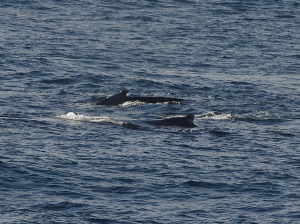
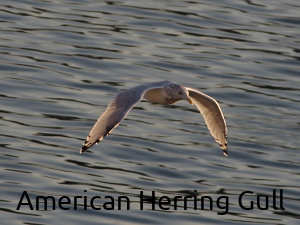
Pleasant day, but with few birds around, mainly American Herring Gulls plus around three White-throated Sparrows on board the ship. Highlight of the day was the sighting of a small school of whales which the ship passed before they dived. Because of the calm, flat sea many other whale ‘blows’ were seen but must were in the distance.
27th September 2012, St John's, Newfoundland
In port.
28th September 2012, Grand Banks
Weather: A low pressure was to the north of Newfoundland and a high pressure system to the south. Early morning; misty with some drizzle; later on as we cleared the cold front from the low pressure area, it became sunny but with some partial cloud, Moderate to rough sea, wind Force 5, from the north.
In the morning there were plenty of Great Shearwaters with lesser numbers of Cory's Shearwaters.
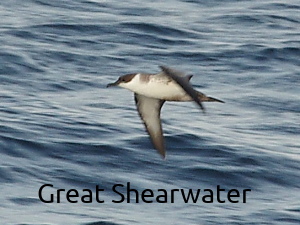
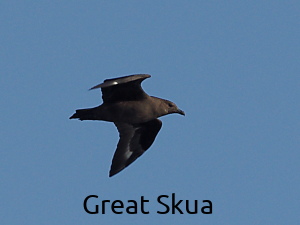
Most of the shearwaters were feeding or resting on the ocean. It was easy to tell the difference, the Great had a more direct way of flying, and in any decent light the dark bill, dark cap, white neck and sharper difference between the white belly and dark upperparts is easily noticed. A few Fulmars and Skuas were around, the skuas being large hulking type and most of the ones which were identified were Greats with some Pomarines, several not being identified. No South Polar Skuas were identified. The presence of or lack of tail extensions was not always seen especially as the Great's feet can slightly project beyond the moulting tail feathers. A couple of American Herring Gulls and a Great Black-backed Gull were noted.
Later in the morning the sun appeared, as did quite a few Leach's Petrels. Also with the Leach's were two flocks, consisting of 5 or 7 birds each, of somewhat larger birds with long, slender wings with a slight ‘elbow’, longish pointed tails and all dark. They resembled slender black crucifixes.They mainly flew in the fashion of their larger congeners, the shearwaters, gliding along the troughs and peaks of the ocean swell. Unfortunately because of the problems with finding the birds in the camera viewfinder no photograph was taken. I cannot cope with photographing birds which fly into troughs and out again on a ship which is pitching and rolling because of the sea! My conclusion was that they were Bulwer's Petrels, but here on the Grand Banks, they are a couple of hundred miles north of the range given by the IUCM maps.
Soon afterwards a flock of half-a-dozen small chocolate-brown petrels were seen fluttering around in the sunlight. Reminiscent of bats and with their large white, wrap-around rumps were considered to be Wilson's Petrels.
In the afternoon, the numbers of shearwaters decreased, the ones which remained being mainly Great. A lot more skuas were seen, most resting on the sea. Also seen were individual Grey Phalaropes, most must have been on the ocean and disturbed by the ship showing off their grey plumage with white wing bars and collars when they flew.
A few Gannets and Fulmars also flew around.
29th September 2012, Labrador Basin
Weather: The low pressure had followed us and was now south of Greenland. Mainly overcast in the morning, sunny with showers in the afternoon; Rough seas, wind Force 7 from the west.
In the morning, lot more skuas, with some Cory's Shearwaters and a flock of Grey Phalaropes.
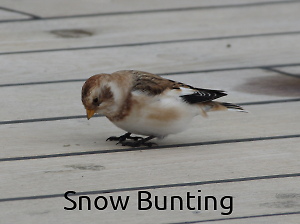
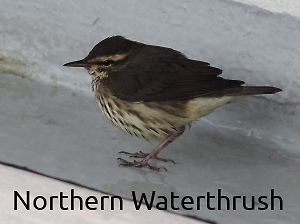
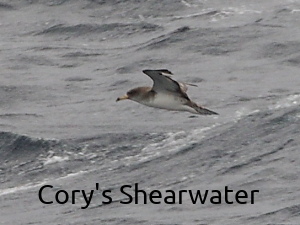
The afternoon brought much lower numbers of skuas and Cory's Shearwaters, but had an increase in the numbers of Great Shearwaters, with several small flocks all moving steadily south rather than feeding.
Various small passerines were also aboard, either having arrived overnight or during the day. These included one Northern Waterthrush, two plus Snow Buntings and at least two White-throated Sparrows. The Snow Buntings stayed on the top deck of the boat with occasional flights off the boat but always returned within ten minutes or so. They were still on board at dusk. The Northern Waterthrush crept around among the deck equipment, but sometime during the day it flew into a glass window, appeared to recover but was, like the Snow Buntings, gone the following morning. The White-throated Sparrows appeared to live very comfortably.
30th September 2012, Mid-Atlantic Ridge
Weather: The low pressure had moved with us and was now still to the north but over Iceland. Partially cloudy with showers; Moderate seas, wind Force 5 from the south-west.
All day large numbers of Great Shearwaters in flocks ranging from c20 birds to 200 plus moving south across the track of the ship. The flocks flew low and steady and not diverting from their course.
In the afternoon a few skuas present as well as an auk of some kind. One Dolphin seen.
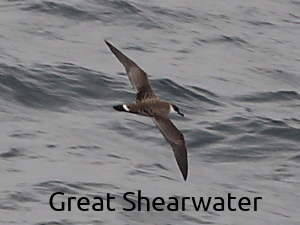
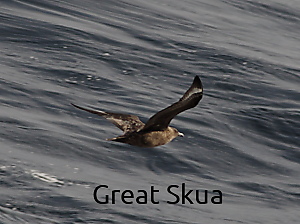
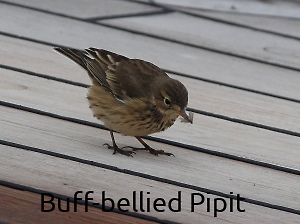
On board one Buff-breasted Pipit with the ever present White-throated Sparrows. The Buff-breasted Pipit was the only bird apart from the White-throated Sparrows which was able to find food aboard.
1st October 2012, Porcupine Abyss
Weather: The low pressure area was now to the east of Icleland, the Azores high was to the south and tropicalstorm 'Nadine' was well to our south-west. Overcast; Moderate seas, wind Force 5 from the south-west.
Few birds seen at sea, one Great Shearwater early on and then only intermittent sightings of Gannets and Fulmars.
At least one White-throated Sparrow still aboard, living on bread and biscuit scraps and moving around the rear decks and the crew's workshop.
2nd October 2012, Channel Approaches
Weather: Overcast again; Moderate to Rough seas, wind Force 5 from the south-west.
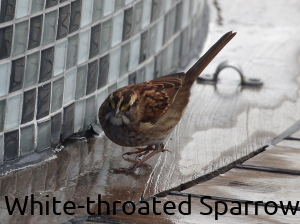
Just Gannets and Fulmars again.
The White-throated Sparrow living happily still on the rear decks, it's more noticeable in the early morning when it is feeding. One of its hidey holes is a recess in the rear pool, emptied for the last two days for repairs.
3rd October 2012, Southampton
Three hours after docking, the White-throated Sparrow was feeding quite happily in its normal places showing no inclination to jump ship!
Wrap-up
Whilst landing on a vessel in mid-ocean may temporary save its life, a terrestrial bird still has lots of problems; one is that of food and water. Sparrows and finches have the best chance of getting food scraps in the form of bread crumbs and the like, warblers and pipits will find dead insects on the deck and in the various gullies and scuppers washed there by the rain and the hosing of the decks. Hosing of the decks is another problem, this is done at first light and can be potential trouble for a bird when it gets its plumage soaked, as a Manx Shearwater found out. The regular hosing down is done with seawater and can contaminate any potential food with salt. Water is another another problem, unless it rains, any water lying around comes from the sea. Some worm eating birds such as the Northern Waterthrush have no chance of finding any suitable food on board.
Passing through the area of the Grand Banks makes one realize how rich in marine life they still are and much richer they must have been before all the cod was fished out. That rich marine life exists is because of the shape of the underlying land, the cold Labrador current running south-west and the north-east passage of the Gulf stream creating a very rich environment.
The lack of numbers of Leach's Petrels was a surprise to me, considering the two largest breeding colonies are in Newfoundland (40% of the world's population breed in Baccalieu Island alone), maybe the end of September is too late. Also only a couple of Puffins were seen even though the two largest Puffin colonies in America are also in Newfoundland.
Also a lookout was made for South Polar Skuas, but none were identified satisfactory. The identification criteria used was:-
- Any large skua which looked pale instead of brown/black/grey. The only pale-phased skuas seen were Arctic.
- Any moulting large skua which looked to be at the end of its moult rather than the beginning.
- Any dark large skua which looked a cold grey or had a pale greyish collar rather than a golden/cinnamon nape patch.

